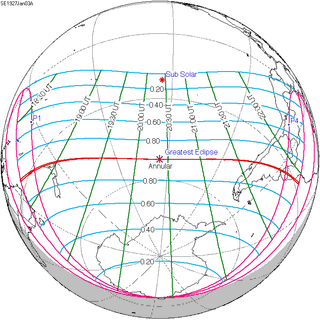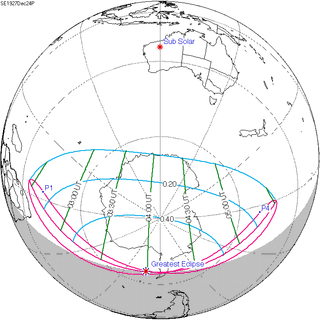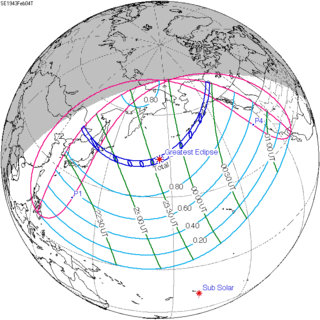Solar eclipse of January 24, 1925
| Solar eclipse of January 24, 1925 | |
|---|---|
 Map | |
| Type of eclipse | |
| Nature | Total |
| Gamma | 0.8661 |
| Magnitude | 1.0304 |
| Maximum eclipse | |
| Duration | 152 sec (2 m 32 s) |
| Coordinates | 40°30′N 49°36′W / 40.5°N 49.6°W |
| Max. width of band | 206 km (128 mi) |
| Times (UTC) | |
| Greatest eclipse | 14:54:03 |
| References | |
| Saros | 120 (56 of 71) |
| Catalog # (SE5000) | 9339 |
A total solar eclipse occurred on January 24, 1925. A solar eclipse occurs when the Moon passes between Earth and the Sun, thereby totally or partly obscuring the image of the Sun for a viewer on Earth. A total solar eclipse occurs when the Moon's apparent diameter is larger than the Sun's, blocking all direct sunlight, turning day into darkness. Totality occurs in a narrow path across Earth's surface, with the partial solar eclipse visible over a surrounding region thousands of kilometres wide.
Observations
It was seen in New York City. It was reported that those above 96th Street in Manhattan saw a total solar eclipse while those below 96th Street saw a partial eclipse.[1]
Related eclipses
Solar eclipses 1924-1928
Each member in a semester series of solar eclipses repeats approximately every 177 days and 4 hours (a semester) at alternating nodes of the Moon's orbit.
| Solar eclipse series sets from 1924-1928 | ||||
|---|---|---|---|---|
| Ascending node | Descending node | |||
| 115 | July 31, 1924 Partial |
120 | January 24, 1925 Total | |
| 125 | July 20, 1925 Annular |
130 | January 14, 1926 Total | |
| 135 | July 9, 1926 Annular |
140 | January 3, 1927 Annular | |
| 145 | June 29, 1927 Total |
150 | December 24, 1927 Partial | |
| 155 | June 17, 1928 Partial | |||
Saros 120
It is a part of Saros cycle 120, repeating every 18 years, 11 days, containing 71 events. The series started with partial solar eclipse on May 27, 933 AD, and reached an annular eclipse on August 11, 1059. It was a hybrid event for 3 dates: May 8, 1510, through May 29, 1546, and total eclipses from June 8, 1564, through March 30, 2033. The series ends at member 71 as a partial eclipse on July 7, 2195. The longest duration of totality was 2 minutes, 50 seconds on March 9, 1997.[2]
| Series members 55–65 occur between 1901 and 2100 | ||
|---|---|---|
| 55 | 56 | 57 |
 January 14, 1907 |
 January 24, 1925 |
 February 4, 1943 |
| 58 | 59 | 60 |
 February 15, 1961 |
 February 26, 1979 |
 March 9, 1997 |
| 61 | 62 | 63 |
 March 20, 2015 |
 March 30, 2033 |
 April 11, 2051 |
| 64 | 65 | |
 April 21, 2069 |
 May 2, 2087 | |
See also
Notes
References
- http://eclipse.gsfc.nasa.gov/SEplot/SEplot1901/SE1925Jan24T.GIF
- Foto and sketchs of Solar Corona January 24, 1925
- Total Solar Eclipse of January 24, 1925 in New York
| Wikimedia Commons has media related to Solar eclipse of 1925 January 24. |
